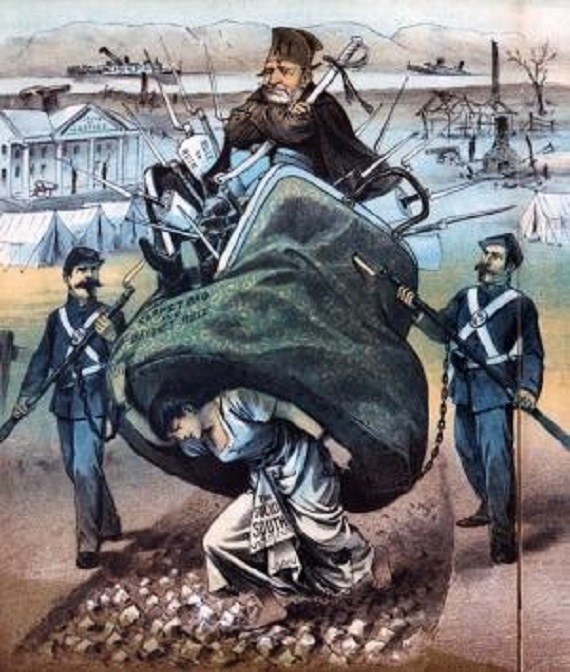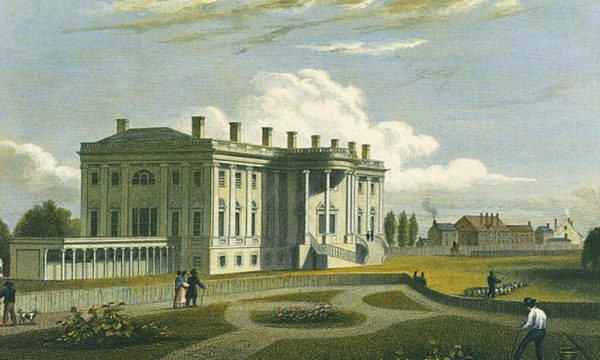Portraying a furtive agenda as a benevolent endeavor has occurred frequently throughout our history. Unscrupulous politicians have been able to hoodwink the public because it takes a while for their fraudulence to be discovered; Sometimes decades. The Reconstruction of Southern states is a classic example of this phenomenon. There were rational, well-thought out strategies put forth for re-admitting Southern states back into the Union after the Civil War. Unfortunately Radical Republicans were able to implement a “reconstruction” of the defeated South that was self-serving rather than public-spirited. Although historians agree that Reconstruction failed, the reasons given for its failure vary based on the political persuasion of the historian.
The Reconstruction experiment took place during one of the most corrupt periods in our history: the 12 years from 1865 to 1877. During that destabilized time, legitimate congressional proceedings as well as provisions of the Constitution were often ignored. Basically, four Reconstruction Acts, hastily and questionably enacted, converted Southern states into conquered provinces, each controlled by a military commander with unlimited power. Bizarrely, it must have been assumed that peremptory measures could expeditiously reverse the South’s long-standing social structure. Freed slaves were led to believe this was imminent and one slave stated: “Bottom rung on top now, boss.” But, in the long run the flawed Reconstruction efforts harmed freedmen more than it helped them.
At the time of the Reconstruction era, the existing states were mostly composed of rural areas whose news came from penny newspapers composed of roughly four pages without advertising. As these newspapers were usually issued on a weekly basis and had to be hand-delivered, what they reported was already several days old. But their reporting was surprisingly accurate. Also, editors and journalists with many newspapers, especially those published in or around Southern states, were not fooled by the political hype about Reconstruction. Their reporting of Reconstruction’s effects, as well as the side-effects, was not favorable.
Covertly, Radical Republicans sought to permanently reduce the South’s influence on national elections. Exploiting the chaotic post-war conditions, these interlopers thought they could use their control of the South to assist their goal of establishing Republican hegemony throughout the nation. Southerners who were deemed to have taken part in the war effort were not allowed to vote or hold public office. This tactic suppressed an enormous amount of opposition Democratic votes. Granting the franchise to freed slaves was a noble-sounding endeavor, but Radical Republicans felt that freed slaves could be molded into a malleable bloc of voters who could be manipulated to serve Republican wishes.
However, a deteriorating national economy, worsened by the 1873 depression, lessened the zeal as well as the ability to “revolutionize” the South. Coupled with these dire fiscal conditions, was the growing realization by the public that Reconstruction efforts were more vindictive than humanitarian. The North had never been solidly behind the Reconstruction of the South and a fear that freed slaves would migrate into their region mitigated Northern zeal for altering the South’s social structure. Finally, a struggling Presidential candidate in a contested election agreed to end the ill-fated Reconstruction experiment in exchange for badly needed electoral votes from three Southern states.
Reconstruction was not phased out in a logical step-by-step manner. It just ended, abandoning the freedmen to fend for themselves without any means of livelihood. If occupying Union troops and Northern interlopers had conducted Reconstruction in the humanitarian way some historians depict it, freed slaves might have felt encouraged to migrate en masse into the North. But instead, they chose to remain in the South with its ravaged economy and infrastructure. Many freedmen negotiated work arrangements with their former masters, primarily sharecropping. Northern investors profited by financing sharecropping arrangements. Many of these same Northern investors had profited by financing slave plantations.
Contrary to what many think, the great migration of Southern Blacks into the North didn’t occur with the end of the Civil War nor during Reconstruction. Nor did Blacks relocate to the North simply to escape oppression in the South. No effort was made to make Blacks feel welcome in the North until the outbreak of World War One. The workforce in the North was almost decimated when masses of Northern men were called into the armed forces and rigid restrictions were placed on foreign immigration. At that point the North engaged in a desperate campaign, including monetary payments, to entice Southern Blacks to take jobs in the North and save its economy. This began a Northward migration of Southern Blacks that continued in varying degrees until roughly the 1960s. Around that time, Blacks began returning to the South in massive numbers, realizing that there was no such thing as a “Promised Land” in either North or South.
The term “Second Reconstruction” is used to describe that umbrella of social changes brought about by the Civil Rights Movement. This version of Reconstruction was presented to the public by nationwide electronic media; a far cry from the weekly newspapers of the 1800s. The awesome power of electronic media was able to create a Left-wing folklore about civil rights that controlled how news was allowed to be reported. This one-sided folklore also took over academia and the entertainment field, creating the Leftist expedient known as “political correctness.” Hardly a week would go by without a word or phrase, previously considered as innocuous, being redefined as malevolent.
The Civil Rights laws were soon infected with “mission creep”: the expansion of a legislative act beyond its original goals. Although Americans suspected that something was not quite right , media proselytizing had so intimidated them that they were reluctant to speak out. Today Civil Rights has morphed into “Social Justice”, a more inclusive term that demands even more societal cleansing. The social justice campaign to tear down Confederate monuments was a forerunner for tearing down monuments honoring the nation’s founders. The public now knows that the social justice backstairs goal is erasing American history and erasing America’s history sets the stage for eradicating our culture.
There were numerous so-called Civil Rights laws enacted, a classic example being the Voting Rights Act of 1965. A brief look at the history of this Act shows how the Left used “mission creep”to infringe on the Constitutional rights of Southerners. The bill was originally scheduled to last five years, from 1965 to 1970, a period when Washington bureaucrats took control of voting procedures in Southern states. But in 1970 the bureaucratic control was extended another five years to 1975. Of course, Leftist Democrats were not about give up Big Brother monitoring of the South. So, in 1975 the Act was again extended. This third extension added seven additional years until 1982.
Not only did Democrats keep the Act alive beyond 1982, they extended it for another whopping 25 years. This kept Washington bureaucrats in control of the South’s voting procedures until 2007, but as that expiration date approached, Democrats began to get restless. So in 2006 the bill was extended for yet another 25 years. At that time few persons, North or South, actually thought Southern society had changed little since 1965; a 50 year period of the most radical societal changes in our nation’s history. As of 2006, massive numbers of Blacks from other regions had been migrating into the Southern region for years. There were also numerous high-ranking Blacks in Southern state governments: a Governor, numerous Mayors, cabinet members and councilmen, members of the legislature, and election officials.
Although in 2006 Democrats had to know the Law was no longer needed, their 25 year extension prevented Southern states from conducting their voting as other states do until the year 2031. Common sense briefly took precedence over political chicanery in 2013. The Supreme Court ruled that sections of the Act, primarily pre-clearance from the DOJ for voting procedures, were unconstitutional. Needless to say, this Supreme Court decision enraged Leftist do-gooders who claimed that discriminatory voter requirements would ensue. As an example of a discriminatory voting regulation, they cited the requirement that voters prove their identity with a photo ID.
The 1992 amendment to the Voting Rights Act was to accommodate “linguistic pluralism.” This revision required that voting ballots must also be in languages of significant immigrant groups in voting districts as well as English. If immigrants are 5% or more of a voting district, taxpayers must provide easily understood election procedures, newspaper ads, multilingual polling place attendants, and voting assistance for persons who cannot read, speak, write, or understand English. This means that every aspect of the election process must be translated and available in several languages at a tremendous cost to the state. Skeptical persons like myself suspect that if immigrants didn’t usually vote Democratic, these taxpayer-funded language accommodations might not have been enacted.
This drastic 1992 “linguistic pluralism” amendment shows how much we’ve changed since the time when immigrants had to remain on Ellis Island until they were sufficiently proficient with the English language to get by in their new country. Unbelievably ill-advised and foolish, this “linguistic pluralism” voting change is just one of the legislative lunacies imposed on American society during the last half century. Luckily. many Americans are no longer intimidated by national media, so they are willing to speak out about the egregious harm government has inflicted on our nation since the 1960s.






